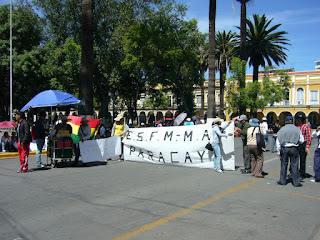Mission Accomplished!
This
morning was an early start as Vito, the man who makes the uniforms
for the children, was coming to pick me up and we would go up to the
High Valleys together. On the way I could see that Cochabamba is
growing tremendously. Vito told me that one of his workers had bought
a plot 15 years ago for US$800 and he had just sold it for US$40,000!
This has to be money from the drug trafficking circuit because in
terms of normal salaries this simply does not make sense.
In
recent years there has been a lot of building in the communities on
the road up to San Benito because many people emigrated to Spain and
other parts of Europe and started building veritable mansions with
their savings. However, most of the migrants have now returned due
to the economic crisis in Europe so most of these fantasies are
unfinished shells.
When
we arrived in San Benito, many families were already at the school,
but we could not start until the people from the puna and other
outlying districts arrived so there was quite a wait. The president
of the the “Social Vigilance Committee” was there. Despite the
threatening-sounding title, she was actually quite a nice lady.
No
gathering in Bolivia can get started without the inevitable speeches.
First of all the school coordinator said a few words, then the
“Social Vigilance” lady, then Primo and then me. The new
headmistress then out in an appearance and also made her speech.
Significantly she as well as all the other educational authorities
are now Aymaras, so the trend continues.
With
76 beneficiaries this year, distributing everything takes quite a lot
longer than it did when we first started. However, Primo has got it
down to a fine art by now: first of all school materials; then
uniforms and schoolbags; next shoes; then socks – boys under 11,
boys over 11, girls under 11, girls over 11; lastly toiletries.
As
we were finishing, the mayor and two lady councillors arrived, so
more speeches had to be made. The mayor also gave me a plaque in
recognition of the 10 years that La Esperanza has been operating in
San Benito. To keep the children entertained during this second round
of speech-making we distributed some lunch.
Several
mothers had brought along bags of peaches for me but, of course, as I
am travelling tomorrow I had to leave behind about 10kg. of peaches!
San Benito is the peach-growing “capital”, although it seems that
this year due to lack of rain they are having problems with the crop.
It
was well after 4 by the time I got back down to Cochabamba, but at
least the mission has been accomplished.





